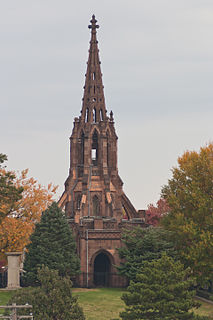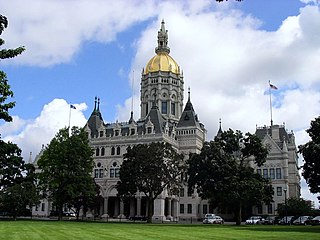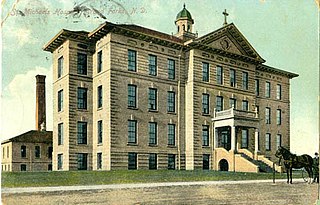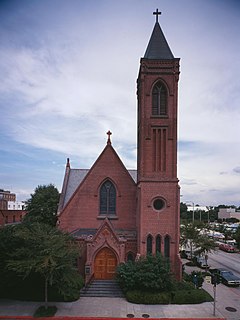Related Research Articles
Robert Cary Long Jr. (1810–1849) was the son of a late 18th Century - early 19th Century famous architect Robert Cary Long Sr. in Baltimore, Maryland and also himself, a well-known 19th Century architect who also practiced in Baltimore. His works in the city included:
Grace Episcopal Church, or variants thereof, may refer to the following:
St. James Episcopal Church, or variants thereof, may refer to: (sorted by state, then city/town)
St. Stephen's Episcopal Church, or variants thereof, may refer to:

Gordon W. Lloyd was an architect of English origin, whose work was primarily in the American Midwest. After being taught by his uncle, Ewan Christian, at the Royal Academy, Lloyd moved to Detroit in 1858. There he established himself as a popular architect of Episcopal churches and cathedrals in the region, mostly in the states of Michigan, Ohio and Pennsylvania. In addition to churches, Lloyd designed several secular works, such as commercial buildings, residences and an insane asylum. Though his office was in Detroit, Lloyd lived across the river in Windsor, Ontario, Canada.

Reuben Harrison Hunt, also known as R. H. Hunt, was an American architect who spent most of his life in Chattanooga, Tennessee. He is considered to have been one of the city's most significant early architects. He also designed major public building projects in other states. He was a principal of the R.H. Hunt and Co. firm.

John Rudolph Niernsee was an American architect. He served as the head architect for the Baltimore and Ohio Railroad.
Henry C. Dudley (1813–1894), known also as Henry Dudley, was an English-born North American architect, known for his Gothic Revival churches. He was a founding member of the American Institute of Architects and designed a large number of churches, among them Saint Paul's Episcopal Cathedral in Syracuse, New York, built in 1884, and Trinity Church, completed in 1858.

Richard Michell Upjohn, FAIA, was an American architect, co-founder and president of the American Institute of Architects.

Edward Brickell White, also known as E. B. White, was an American architect. He was known for his Gothic Revival architecture and his use of Roman and Greek designs.
St. Philip's Episcopal Church, or variants thereof, may refer to the following:

George Hancock was an architect active in North Dakota, Montana and Minnesota. He moved to the area in 1882, settling in Fargo, North Dakota with his brother Walter when they were 33 and 17, respectively. After a fire destroyed much of Downtown Fargo in 1893, George and Walter designed around half of the replacement buildings. After advocating for a 1917 law requiring architects in North Dakota to be licensed, he and Walter became the first two licensed architects in the state.
Hobart Brown Upjohn (1876–1949) was an American architect, best known for designing a number of ecclesiastical and educational structures in New York and in North Carolina. He also designed a number of significant private homes. His firm produced a total of about 150 projects, a third of which were in North Carolina.
Charles E. Choate was a U.S. architect who worked in Georgia, Florida, and Alabama. He lived for ten years in Tennille, Georgia.

James B. Cook was an English-trained architect who worked in Memphis, Tennessee in the 1800s.
Frank E. Wetherell (1869-1961) was an architect in the U.S. state of Iowa who worked during 1892–1931. He founded the second oldest architectural firm in the state in Des Moines, Iowa, in 1905.
George Washington Kramer (1848-1938) was an American architect. He worked also in the partnership of Weary & Kramer with Frank O. Weary.

John Welch was an architect and builder of Brooklyn, New York who designed numerous churches.

The St. James Episcopal Church is an Episcopal church located at 208 North 4th Street in Baton Rouge, Louisiana founded in 1840. Its Gothic Revival-style building, built during 1890-1895, was designed by architect Colonel W.L. Stevens. It replaced the original frame building of the church which had been built in 1845-46. The church engaged the nationally recognized roofing & restoration firm The Durable Restoration Company to provide repair and restoration of the 150 year old slate roof.
Norman Foote Marsh (1871-1955) was an American architect based in Los Angeles, California who worked mostly in California and Arizona.
References
- 1 2 "St. James Episcopal Church" (PDF). State of Louisiana's Division of Historic Preservation. 1978. Retrieved October 29, 2017. with photo
- 1 2 3 "National Register Information System". National Register of Historic Places . National Park Service. July 9, 2010.